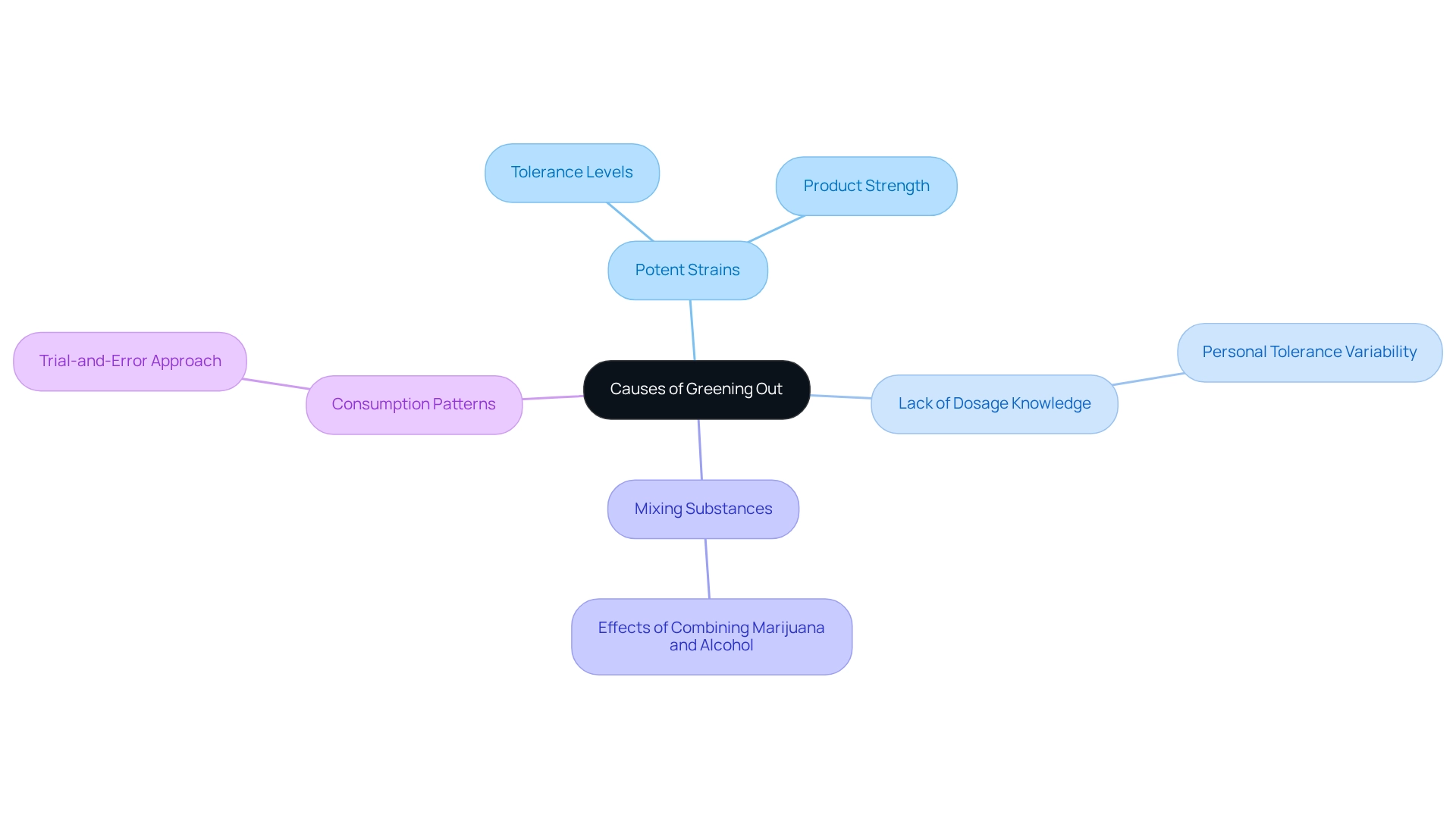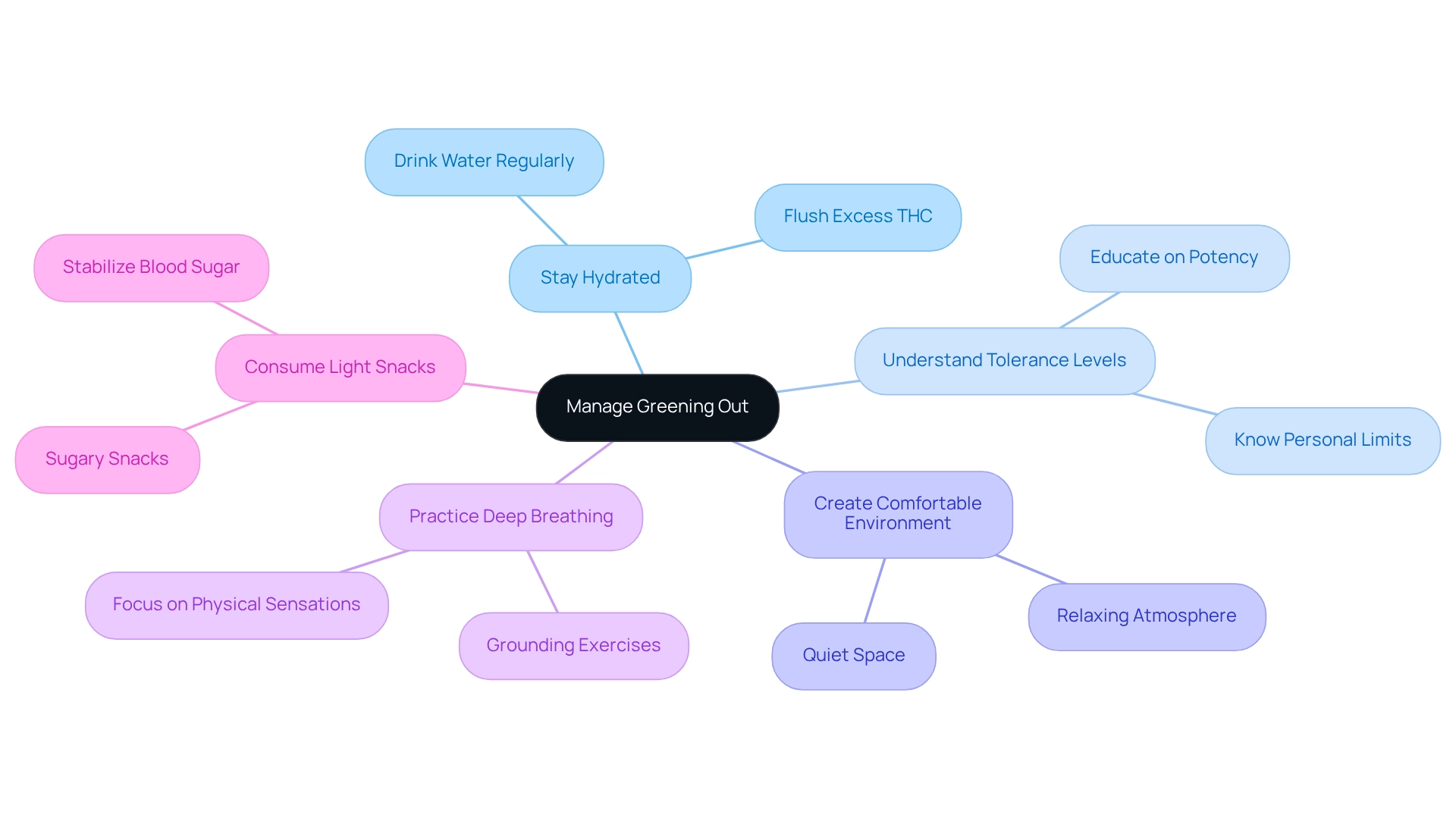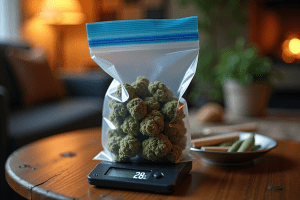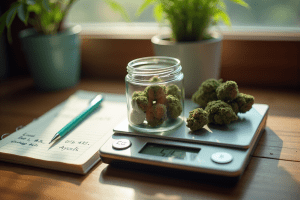Overview
Greening out refers to the uncomfortable physical and psychological effects that can arise after consuming too much marijuana, especially high-THC products. This can lead to symptoms like nausea, dizziness, and anxiety. It’s vital for us to understand our personal tolerance levels and practice responsible consumption to prevent greening out. Education and awareness are key as more individuals begin to explore marijuana use.
Have you ever felt overwhelmed after using marijuana? You’re not alone. Many people experience these feelings, and it’s important to recognize them. By being informed and mindful of our choices, we can create a safer and more enjoyable experience together. Let’s prioritize understanding and support each other in this journey.
Introduction
As cannabis consumption becomes increasingly mainstream, more individuals are stepping into this complex world, often without fully understanding the potential challenges they may face. One such concern is the phenomenon known as “greening out.” This term describes the uncomfortable physical and psychological effects that can arise from consuming too much cannabis too quickly.
Have you ever wondered what causes this sensation? This article delves into the intricacies of greening out, exploring its causes, symptoms, and effective management strategies. With insights from experts and real-life experiences, we aim to provide you with a comprehensive understanding of how to navigate your cannabis journey safely and responsibly.
Together, we can ensure that your encounters with this potent plant remain enjoyable rather than overwhelming.
Define Greening Out: Understanding the Concept
What does greening out mean? It describes the negative physical and psychological effects that may occur from ingesting an excessive quantity of marijuana in a brief period. This phenomenon is particularly linked to high-THC products, which can lead to symptoms like nausea, dizziness, and anxiety. As more people explore marijuana, it becomes increasingly important to understand what greening out means, especially for newcomers navigating the complexities of dispensaries. The Centers for Disease Control and Prevention highlights that marijuana overdose is often associated with edible products. It can take up to two hours for users to feel the effects, and this delayed onset can lead to unintentional overconsumption. Recognizing your limits and the potential repercussions of overindulgence is crucial. When visiting a dispensary, we encourage you to consult with knowledgeable budtenders who can assist you in choosing the right products and dosages tailored to your experience level.
There are two primary types of dispensaries: medical and recreational. Medical dispensaries cater to patients with a valid medical marijuana card, offering products formulated for specific medical conditions. On the other hand, recreational dispensaries serve adults aged 21 and older, providing a variety of products, including flower, edibles, concentrates, vape cartridges, topicals, and tinctures. It’s essential for new consumers to familiarize themselves with local marijuana laws and regulations regarding use and possession, including legal purchase limits and age requirements, particularly because understanding what greening out means is crucial, as real-world examples show that even experienced individuals can experience it, highlighting the need for education and awareness. For instance, some individuals have reported feeling overwhelmed and disoriented after consuming a potent edible, leading to a temporary withdrawal from social situations. Additionally, Danny DeVito has pointed out the societal benefits of decriminalizing marijuana, which can foster a more informed and responsible culture regarding its use.
Moreover, the evolving legal landscape surrounding marijuana, as documented by the State Cannabis Policy Enactment Database, underscores the importance of staying updated about regulations that may influence consumption practices. In a light-hearted analogy, Joe Rogan compared the risk of marijuana overconsumption to fast food, suggesting that just as one can overindulge in unhealthy snacks, those who consume marijuana should also be mindful of their intake. This analogy serves as a gentle reminder of the importance of moderation and awareness in your experiences with marijuana, reinforcing the value of responsible use and the role of regulated, lab-tested products in ensuring safety.
Identify Causes of Greening Out: Factors Leading to Overconsumption
What does greening out mean? It refers to an occurrence that can happen due to several interconnected factors, especially among those who are new to marijuana. One primary cause is the consumption of potent strains or concentrates, which can significantly exceed the tolerance levels of inexperienced individuals. Many people may underestimate the strength of these products, leading to unintentional overconsumption. Additionally, a lack of knowledge about proper dosage can further complicate this issue. For instance, new users might not recognize their personal tolerance levels, which can vary greatly based on factors like body weight, metabolism, and previous experience with marijuana.
Statistics indicate that in 2021, over half a million young individuals aged 16 to 24 in the UK were believed to be using marijuana regularly, highlighting its prevalence among new consumers. Moreover, in 2015, 8.3 percent of Americans aged 12 and older reported using marijuana in the past month, underscoring the increasing number of individuals entering the marijuana space.
Another significant factor is the combination of marijuana with other substances, particularly alcohol. Mixing these can amplify the effects of both, which raises the question of what does greening out mean. Reports suggest that psychiatrists across the U.S. are seeing a rising number of patients experiencing delusions and paranoia linked to cannabis use, which emphasizes the importance of understanding these risks. As noted by Arista Recovery Staff, “These resources can provide valuable guidance and support, but they should not replace professional medical advice or treatment.”
Furthermore, consumption patterns among new users often reflect a trial-and-error approach, where individuals may consume more than intended in hopes of achieving desired effects. This behavior can lead to adverse experiences, reinforcing the need for education on safe consumption practices. By recognizing these causes, both new and experienced users can make informed choices, ultimately promoting safer use of the substance. Additionally, the Medical Marijuana Research Act aims to enhance research accessibility for marijuana, which could further inform safe practices in the future.
Recognize Symptoms of Greening Out: Physical and Psychological Indicators
To understand what does greening out mean, it is essential to recognize the range of symptoms it presents, both physical and psychological. Physically, you might experience nausea, vomiting, dizziness, and excessive sweating. These can be quite alarming and often lead to a heightened sense of discomfort. On the psychological side, it is important to understand what does greening out mean, as it can bring about increased anxiety, paranoia, and confusion, with some individuals feeling disoriented or having trouble concentrating. Recognizing these symptoms is crucial for timely intervention.
Staying hydrated and seeking a calm environment can significantly ease your discomfort. For instance, sipping on water or herbal tea may help alleviate nausea, while finding a quiet space can reduce anxiety. Research shows that nausea and anxiety are common in cases of marijuana overconsumption, with many users reporting these experiences. This underscores the importance of educating ourselves about responsible usage, especially as marijuana legalization and policy reform continue to evolve.
Real-life accounts from users reveal the diverse experiences of greening out and highlight what does greening out mean, as many express feelings of panic and confusion during such episodes. Case studies indicate that integrating counseling services can enhance patient engagement for those struggling with marijuana dependence, particularly in managing symptoms associated with marijuana hyperemesis syndrome (CHS). For example, the study ‘Substance Use Counseling for CHS Patients’ highlights the vital role of counseling in supporting cessation efforts for individuals facing marijuana dependence.
By recognizing the physical and psychological signs of what does greening out mean, we can better manage our interactions with marijuana and make informed choices about our usage. As Loganathan points out, it’s essential to examine the public health implications of marijuana legalization and its effects on healthcare utilization, further stressing the need for awareness and education in this evolving landscape.
Manage Greening Out: Effective Strategies for Relief
Effectively managing what does greening out mean involves several key strategies that we can embrace together. First and foremost, staying hydrated is paramount; drinking water helps flush excess THC from our systems, which can mitigate uncomfortable symptoms. Have you ever considered how understanding your personal tolerance levels can create a more enjoyable experience with cannabis? Implementing prevention techniques is essential. Additionally, creating a comfortable and quiet environment allows for relaxation, further alleviating discomfort.
We can also explore techniques such as deep breathing and grounding exercises—focusing on our physical sensations—which can significantly reduce anxiety and promote a sense of calm. Have you ever tried consuming a light snack, especially something sugary? This can stabilize blood sugar levels and help ease nausea. As Brooke Palladino, a board-certified Psychiatric Mental Health Nurse Practitioner, wisely states, “Awareness about individual tolerance levels along with understanding the potency of marijuana stands paramount to avoid experiencing adverse outcomes related to what does greening out mean.”
It’s crucial to remain calm and refrain from further marijuana use until symptoms subside. This approach ensures a safer and more enjoyable experience for all of us. Remember, we are in this together, and by taking these steps, we can support one another in navigating our experiences with cannabis.
Long-Term Considerations: Preventing Future Incidents
To effectively prevent greening out in the future, it is important to understand what greening out means, along with educating ourselves about marijuana strains, their potency, and our personal tolerance levels. Engaging with reliable resources, such as Leafy Mate, can provide valuable insights into safe marijuana practices. This includes understanding the different types of dispensaries—medical and recreational—and the products they offer.
- Medical dispensaries cater to patients with valid medical marijuana cards, offering products formulated for specific conditions.
- Recreational dispensaries serve adults aged 21 and over without requiring a medical card.
Starting consumption with low doses and gradually increasing them allows us to better understand our limits. Additionally, being mindful of our consumption method—such as choosing lower-THC edibles or avoiding the combination of substances—can significantly mitigate the risk of experiencing greening out.
Long-term strategies for safe marijuana use involve regular self-assessment of our tolerance and the effects of different strains. Research suggests that knowledgeable individuals are less likely to encounter negative effects. Studies show that education on marijuana can lead to safer consumption practices. In fact, many marijuana consumers report feeling overwhelmed by the variety of products available. This is expected to increase, with marijuana sales projected to reach $67.2 billion by 2030. This highlights the importance of direction in making informed decisions, especially through platforms like Leafy Mate, which connect us to reliable medical marijuana physicians and quality brands.
As President Joe Biden remarked, “This lack of aggregated knowledge is a significant impediment not only to the scientific understanding of marijuana but also to the advancement of public policy and the nation’s overall public health.” By promoting a culture of education and responsible use, we can enjoy marijuana while minimizing risks associated with overconsumption. Moreover, understanding the potential addiction and mental health risks linked to marijuana use, especially among teenagers and young adults, is essential for making informed choices. It is also crucial for new consumers to familiarize themselves with local cannabis laws and regulations regarding marijuana use and possession. Together, we can navigate this landscape with awareness and care.
Conclusion
Understanding greening out is vital for anyone entering the world of cannabis. This phenomenon, characterized by adverse effects such as nausea, dizziness, and anxiety, often stems from overconsumption, particularly among inexperienced users. Key factors contributing to greening out include:
- The potency of cannabis products
- A lack of knowledge about personal tolerance
- The mixing of cannabis with other substances
As cannabis use becomes more widespread, it is essential for us to educate ourselves on the potential risks and how to mitigate them.
Recognizing the symptoms of greening out is crucial for effective management. Physical symptoms like nausea and dizziness, alongside psychological effects such as anxiety and confusion, can be distressing. However, strategies such as:
- Staying hydrated
- Finding a calm environment
- Consuming light snacks
can help alleviate discomfort. Awareness of our individual tolerance levels and understanding the potency of different products are also key components of responsible cannabis consumption.
Looking ahead, preventing greening out requires a commitment to education and self-awareness. By starting with low doses and gradually increasing intake, we can better understand our limits and avoid adverse experiences. Engaging with reliable resources and staying informed about the evolving cannabis landscape will empower us to navigate our cannabis journey safely. Ultimately, fostering a culture of responsible use not only enhances our individual experiences but also promotes a more informed community around cannabis consumption.
Frequently Asked Questions
What does “greening out” mean?
Greening out refers to the negative physical and psychological effects that occur from ingesting an excessive quantity of marijuana in a short period, particularly linked to high-THC products. Symptoms may include nausea, dizziness, and anxiety.
What are the common causes of greening out?
Common causes include consuming potent strains or concentrates that exceed personal tolerance levels, lack of knowledge about proper dosage, and mixing marijuana with other substances like alcohol, which can amplify effects.
Who is most likely to experience greening out?
New users and inexperienced individuals are more likely to experience greening out, as they may underestimate the strength of marijuana products and may not recognize their personal tolerance levels.
How long does it take to feel the effects of marijuana edibles?
It can take up to two hours for users to feel the effects of marijuana edibles, which may lead to unintentional overconsumption.
What types of dispensaries are there?
There are two primary types of dispensaries: medical dispensaries, which cater to patients with a valid medical marijuana card, and recreational dispensaries, which serve adults aged 21 and older.
Why is it important to consult with budtenders at dispensaries?
Consulting with knowledgeable budtenders can help consumers choose the right products and dosages tailored to their experience level, reducing the risk of greening out.
What should new consumers be aware of regarding marijuana laws?
New consumers should familiarize themselves with local marijuana laws and regulations, including legal purchase limits and age requirements, to ensure responsible use.
What are some reported experiences of greening out?
Some individuals have reported feeling overwhelmed and disoriented after consuming potent edibles, leading to temporary withdrawal from social situations.
How does the legal landscape of marijuana affect consumption practices?
The evolving legal landscape emphasizes the importance of staying updated about regulations that may influence how marijuana is consumed and understood.
What analogy did Joe Rogan use to explain the risks of marijuana overconsumption?
Joe Rogan compared the risk of marijuana overconsumption to fast food, suggesting that just as one can overindulge in unhealthy snacks, those consuming marijuana should also be mindful of their intake.
Get Your Medical Card
Connect with a licensed physician online in minutes














